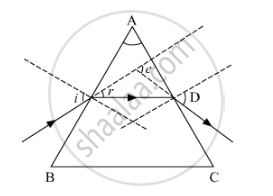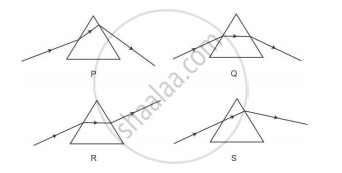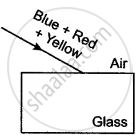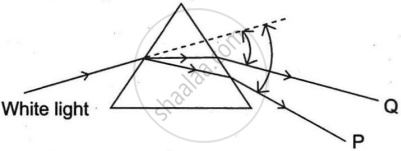Advertisements
Advertisements
प्रश्न
Study the following figure in which a student has marked the angle of incidence (∠i), angle of refraction (∠r), angle of emergence (∠e), angle of prism (∠A) and the angle of deviation (∠D). The correctly marked angles are

(a) ∠A and ∠i
(b) ∠A, ∠i and ∠r
(c) ∠A, ∠i, ∠e and ∠D
(d) ∠A, ∠i, ∠r and ∠D
उत्तर
The correctly marked angles in the given figure are the angle of prism (A) and the angle of incidence (i).
All the angles are correctly marked in the figure shown below.

Hence, the correct answer is option (a).
APPEARS IN
संबंधित प्रश्न
Study the following diagrams in which the path of a ray of light passing through a glass prism as traced by four students P, Q, R and S is shown:

The student who has traced the path correctly is
(A) P
(B) Q
(C) R
(D) S
In the figure given alongside, a narrow beam of white light is shown to pass through a triangular glass prism. After passing through the prism, it produces a spectrum YX on the screen.
State the colour seen (i) at X, and (ii) at Y.
The splitting of white light into its constituent colours is called .............
What do you understand by the term spectrum? Name the various colours present in the spectrum of sunlight.
The frequency range of visible light is from 3.75 × 1014 Hz to 7.5 × 1014 Hz. Calculate its wavelength range. Take speed of light = 3 × 108 m/s.
Which characteristic property of light is responsible for the blue colour of the sky?
Write the range of wavelength of the visible spectrum.
In the figure, a beam of light consisting of three colours blue, red, and yellow is incident on a prism and on a rectangular glass block respectively. Complete the diagram by drawings of the refracted and emergent rays.

What is a rainbow?
In the following diagram showing dispersion of white light by a glass prism, the colours 'P' and 'Q’ respectively are:

